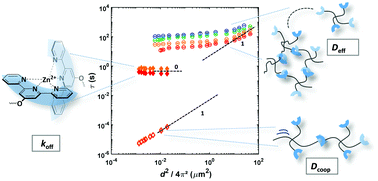Hierarchy of relaxation times in supramolecular polymer model networks†
Abstract
Supramolecular polymer gels are an evolving class of soft materials with a vast number of properties that can be tuned to desired applications. Despite continuous advances concerning polymer synthesis, sustainability or adaptability, a consistent understanding of the interplay between structure, dynamics, and diffusion processes within transient networks is lacking. In this study, the hierarchy of several relaxation processes is investigated, starting from a microscopic perspective of a single sticker dissociation event up to the center-of-mass diffusion of a star-shaped polymer building block on different length scales, as well as the resulting macroscopic mechanical response to applied external stress. In addition to that, a second focus is placed on the gel micro-structure that is analyzed by light scattering. Conversion of the dynamic light scattering (DLS) inverse length scale into real space allows for a combination of relaxation times with those obtained by forced Rayleigh scattering (FRS). For these investigations, a model-type metallo-supramolecular network consisting of narrowly dispersed tetra-arm poly(ethylene glycol)-terpyridine macromolecules that are interconnected via complexation with zinc ions is chosen. Assembling the obtained activation energies reveals that all complex dissociation-governed relaxation processes exhibit similar activation energies.



 Please wait while we load your content...
Please wait while we load your content...